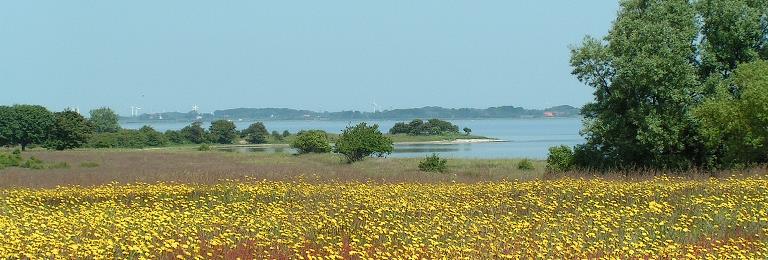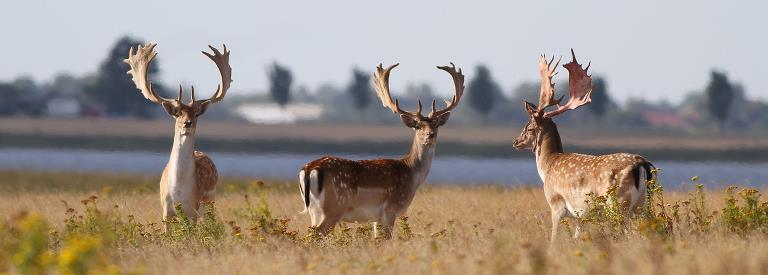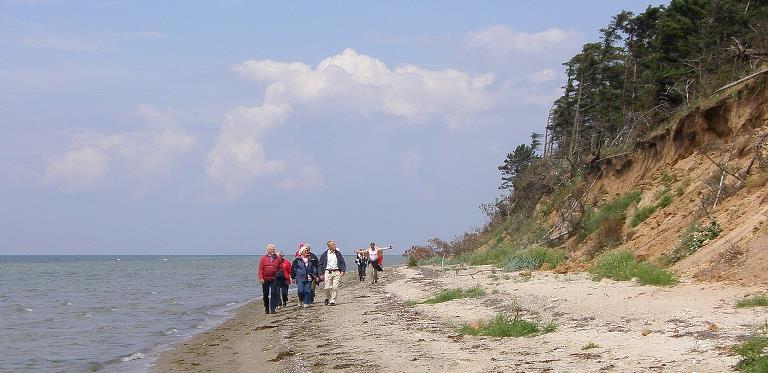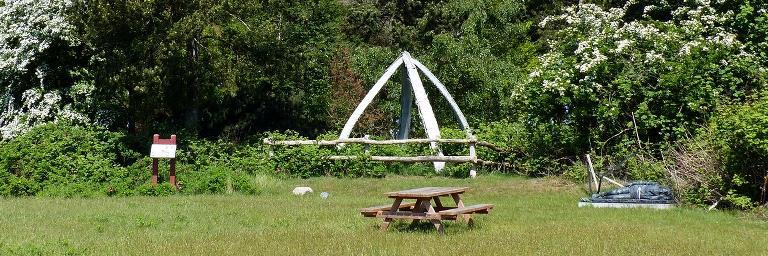Enehøje
The largest island in the fjord, Enehøje, is characterised first and foremost by its wonderfully varied nature. From the island's soft hills with exciting overgrown vegetation and rare insects you can enjoy a beautiful view over Nakskov Fjord. There are also beach lagoons with birds, big deer, mouflons and a wonderful child-friendly beach.

The High Island
Like a breakwater, the almost 3 km long island of Enehøje lies on the edge of the Langeland Belt and protects the other smaller islands in the fjord from large waves.
The name Enehøje is apt, as the island's highest point rises 16 metres above sea level, as does most of flat West Lolland. In fact, there are 17-18 km to higher ground.
The island is owned by the state, so there is public access to most of it. However, the buildings and land near these are privately owned and the northern tip is closed to traffic during the bird breeding season 15/3 - 15/7, but otherwise you can enjoy island life here.
Enehøje is also called Peter Freuchen's Island, as the famous Greenland explorer lived on the island from 1926-40. There are many entertaining stories about his life on Enehøje. As a testimony to Peter Freuchen's stay, his whale beak lighthouse can be seen at the highest point.
A tour of the high island always offers good visual experiences, as in many places you have a fantastic view of Nakskov Fjord and the Langeland Belt.

Nature
Enehøje has an incredibly varied nature. On the leeward side of the island there are dense kelp forests with bays and coves. On the west side we find a steep slope that arises when winter storms rage from the northwest. The material that breaks down forms a small crumb at the southern end. The central parts of the island are dominated by gentle hills with open grassland broken by hedgerows, but there is also a small forest on the highest area. The north end is low with small lakes and coastal lagoons.
The higher soils of Enehøj are very sandy, which is quite unusual for West Lolland. As a result, several plant species are found here that are otherwise rare for the region. The 3 small grey-blue and hairy mouse-ear species are particularly unusual. There are especially many Liden Museurt, but the more branched Kugle Museurt and the coarse 30 cm high Ager Museurt can be seen on the island. The island's character plant is now the Common King's Pea. This plant, which is related to the dandelion, can turn large areas yellow on sunny days. The first half of June is best.
Throughout the island, you may be lucky enough to spot the large and beautiful fallow deer that are the island's primary natural caretakers. The northern tip of the island is also home to a herd of mouflons. These are animals that the Nature Agency has taken over from Storstrøms County. They are only females, so they are extinct, but will enjoy their last days on the beautiful island. In summer, summer holiday visitors often come in the form of a herd of cattle to supplement the grazing of the deer.
Enehøje kaldes også for en sommerfugleø, da du kan opleve mange spændende sommerfugle og andre interessante insekter.
Det meste af nordspidsen er lukket for færdsel i perioden 15/3 – 15/7. Dette område med strandsøerne forventes at blive øens fugleeldorado med mange forskellige ynglende arter. Der har ganske vist været ræve på øen i nogle år, men nu skulle de være udryddet, så nu ventes der i spænding. Fra fugletårnet er der en fin udsigt over søerne, men gå lidt forsigtigt så fuglene ikke forstyrres.
De senere år har der ynglet en del klyder på både nord- og sydspidsen. Det er spændende og flotte fugle, så vi glæder os.

Practical
The Nature Agency has set up tables and benches here and there on Enehøje. Most of them are at the jetty, where there is also a half-roof with information signs. There is a multitoilet at the black barn, where drinking water is also available. In the middle of the island, a shelter with a barbecue area has been built, so you can spend the night on a deserted island. However, this must be booked with Naturstyrelsen, Storstrøm. See the link at the bottom of the page.
You can see Enehøje on the way on the mail boat trip, where it is possible to stay for a few hours if this is arranged with the skipper. You can also join one of the nature guides' tours or book a special tour to Enehøje.

